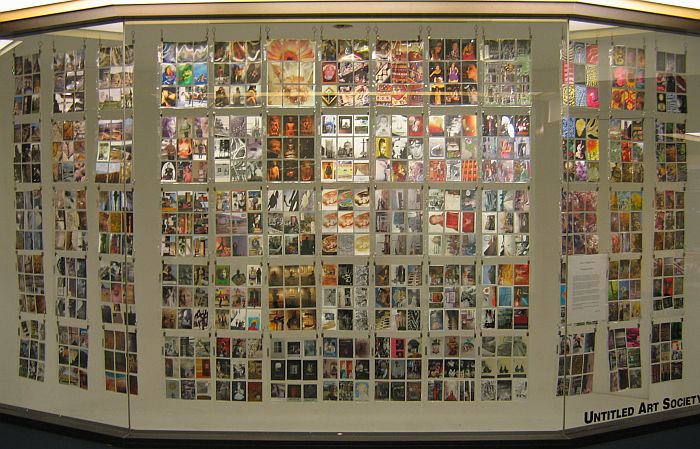CAC Photos 2013-14
Friday, September 26, 2014
Sunday, September 21, 2014
Artist Trading Card SWAP: CAC Wk. 6 and beyond...

WHAT ARE ATCs?
Artist trading cards (or ATCs) are miniature works of art about the same size as modern trading cards baseball cards, or 2 1⁄2 by 3 1⁄2 inches and small enough to fit inside standard card-collector pockets, sleeves or sheets. The ATC movement developed out of the mail art movement and has its origins in Switzerland. Cards are produced in various media, including dry media (pencils, pens, markers, etc.), wet media (watercolor, acrylic paints, etc.), paper media (in the form of collage, paper-cuts, found objects, etc.) or even metals or fiber. The cards are usually traded or exchanged. When sold, they are usually referred to as art card editions and originals (ACEOs).
http://en.wikipedia.org/wiki/Artisttradingcards
ATCsForAll.com: Trading Site IllustratedATCs.com: Trading Site ATC Quarterly Trading Card Questions Original Art Trading Society (OATS)
Steps
Getting started with your own ATCs
Thumbnails:
-
Start with the size in mind. Artist trading cards are 2 1/2 by 3 1/2 inches. This is the size of playing cards and other trading cards. You can even start with mismatched playing cards as a base for collage or altered item artwork. I will also have pre-cut cards for you to use.
-
Cut the background material to size. If you choose to use a background material, you may start by cutting card stock or heavy paper to size. A paper cutter, if you have one, will help you make square, straight cuts quickly.
-
Choose your media. If you work in another medium, such as leather or fabric, you may either cut it to size or work so that the finished result is the correct size.
-
Express yourself or show your style, using your preferred medium or media. If you can do it inside of 3.5 x 2.5 inches, you can make an ATC.
- Drawing and painting are easily done at this size, but so are plenty of other arts, including quilting, photography, crochet, leather work, metal work, and collage. The possibilities are LIMITLESS!
-
Work somewhat quickly. You don't need to be careless when making an ATC, but there's no need to work your masterpiece in miniature, either. ATCs should be simple pieces that you're willing to give away when you're done.
-
Make lots. You'll need a selection of cards. Remember that you will be giving your cards away. "Lots" can be relative. It could be half a dozen or a few dozen, depending on how many you expect to trade.
-
Show your style. Is there a particular palette or medium you prefer or a technique you've been exploring lately? Make YOUR card stand out!

 Sign & Title your cards and attach information on the back. On the back the artist will title the work, list the media, and can include their first name and grade/age. The title is optional, but it will give your recipients or viewers a context in which to view your work. Here is an example:
Sign & Title your cards and attach information on the back. On the back the artist will title the work, list the media, and can include their first name and grade/age. The title is optional, but it will give your recipients or viewers a context in which to view your work. Here is an example:
9. Share. The whole point of ATCs is to trade with other artists, so once you have a selection
of cards, trade them.
CAC will be trading with:
OTHER WAYS TO SHARE/TRADE:
- Find artists or groups in your area that trade cards.
- Attend gatherings of artists in your area, and remind them to bring ATCs to share.
- Carry them with you as you would business cards, so that if you find an occasion to trade or give away a card, they are with you.
- Spread the word. If your local artist community is unfamiliar with artist trading cards, you may have to give away a few cards or offer them with a request for one in return before you get many back.
- Organize a gathering to swap ATCs. Let people know what ATCs are about, and get together to try trading some.
- Look on-line. There are on-line groups that will match you up with others the world over who can mail cards in exchange for yours.
10. Collect others' ATCs.
Michelle Salmans & Rachel Downs-Blair lead the Art Club at Lawrence Free State High School in Kansas. Lawrence is a city of just under 90,000 which houses the University of Kansas, about 40 miles west of Kansas City and 25 miles east of our state capital, Topeka.
*Fun Fact: Ms. Downs-Blair presented about ATCs at NAEA a few years ago and is a huge advocate and knowledge house for the process.
LINKS:
Lawrence Free State High School: http://fshs.usd497.org/
Rachel Downs-Blair: http://downs-blair-art.tumblr.com/
Michelle Salmans: http://salmansinart.weebly.com/
WHEN ARE WE GETTING STARTED?
OCT. 14th & 15th
WHEN ARE WE TRADING?
I plan on making two bulk mailings, one before Winter break and another in the Spring.
DATES: TBD, Before Winter Break
Thursday, September 18, 2014
ELEMENTS & PRINCIPLES OF ART: EMPHASIS & PaTtErN The Art of GustavKlimt: CAC Wks. 3, 4, & 5
Artist of Inspiration: Gustav Klimt |
| The Kiss, Gustav Klimt Notice the juxtaposition of the abstract patterning and the realistic figures. |
THE PROJECT:
Looking at the work of Austrian Art Nouveau painter, Gustav Klimt for inspiration we will create elegant collaged scratchboard portraits. Line, shape, pattern, and the design principle known as Emphasis are the focus of this lesson.
Utilizing Klimt's trademark gold color and intricate pattern work, we will create inspired designs on Gold scratchboard. Patterns applied to areas around a carefully cut out figure from a magazine becomes the signature Klimt look and the focal point in the design. This is accomplished by establishing contrast between the pattern work in the figure and in the background.
Procedures:
More Resources:
See the Klimt Exhibition in Venice from 2012: http://www.mostraklimt.it/
Gustav Klimt - Web Museum: http://www.ibiblio.org/wm/paint/auth/klimt/
Expo-Klimt - Online Museum: http://www.expo-klimt.com/
(Archive) Gustav Klimt - Artchive - essay and links to images: http://www.artchive.com/artchive/K/klimt.html
Gustav Klimt Landscapes from Clark Art Institute:
See the Klimt Exhibition in Venice from 2012: http://www.mostraklimt.it/
Gustav Klimt - Web Museum: http://www.ibiblio.org/wm/paint/auth/klimt/
Expo-Klimt - Online Museum: http://www.expo-klimt.com/
(Archive) Gustav Klimt - Artchive - essay and links to images: http://www.artchive.com/artchive/K/klimt.html
Gustav Klimt Landscapes from Clark Art Institute:
Instagrammmmmm
Instagram's the new shopping mall; it's where all the cool kids are hanging out. But in a sea of selfies and mediocre sunsets on the beach, how do you find the teens with the coolest Instagram pages? We've (Huffington Post) saved you the trouble and gathered some of the best teen Instagrammers the Internet has to offer.
via Huffington Post
2. Jules Spector, @jules.spector
Fourteen-year-old Jules is already a feminist activist, working as a teen advisor for the @girlupcampaign and blogging at Teen Feminist. Her Instagram tracks her travels and activism.
Read on
via Huffington Post
1. Ryan Parrilla, @novess
This 15-year-old New York-based photographer has already caught the eye of nearly 48k followers with beautiful shots of nature and city life.
2. Jules Spector, @jules.spector
3. Mark Otto, @markotto
Ohio teen Mark Otto shows high school life in bright pop colors. Everyday knick-knacks transform into instant art!Read on
Sunday, September 14, 2014
TATTOO A BANANA?!???!??? Seurat, Pointilism, and Edible Art! CAC WK. 2
This week we will tackle POINTILISM.
What is THAT, you ask???
Pointillism is an art technique of
neo-impressionist painting. Both pointillism and stippling are the same thing,
but pointillism is the original name. The basis of pointillism is creating a
bunch of dots in different densities to create a blended image (When looked at
all together) to the viewers. Pointillism was developed by Georges Seurat in
1886 as a variation of the art form impressionism.
Georges Seurat (1859-1891)
"A sunday afternoon on the island of la grande jatte"
(click on the link to learn more about Seurat and his famous painting)
(click on the link to learn more about Seurat and his famous painting)
 detail
detail |
Aman-Jean. 1882-1883 Conté crayon - 62.2 x 47.6 cm New York, The Metropolitan Museum |
 |
| Study for Bathers at Asnières (known as The Echo), 1883 Conté crayon - 31.2 x 24 cm New Haven, Yale University Art Gallery |
Get to the point: Georges Seurat and Pointillism from Nate Heck on Vimeo.
SOOOOOO,
HOW IS IT DONE?
well, check this out....
The Making of "Hero" from Miguel Endara on Vimeo.
Value Scale:

 |
| tiger |
 |
| eye MORE POINTILISM EXAMPLES HERE |
DIDN'T YOU SAY SOMETHING ABOUT A BANANA??????????

WHY NOT,
The technique was conceived by Phil Hansen, author of Tattoo a Banana: And Other Ways to Turn Anything and Everything Into Art . Hansen is a multimedia artist who works at the intersection of "traditional visual art, pointillism, and offbeat techniques, using media that connect to the subject matter, such as karate chops, tricycle wheel imprints, burger grease, and worms." And bananas.
In the video below, he shows exactly how to tattoo a banana. All you need is a banana, a pin, and your imagination.
And for those of you who are itchy about wasting bananas, here's the trick. If you refrigerate the fruit in question, the skin will brown so that you can witness the transformation, but the deterioration of the fruit itself will be restrained, leaving it available for all of your banana needs.
For more information and to share photos of your banana art, visit Phil in the Whaaat?.
I hope to see all of you Art Monkeys next week!!
Ms. Jen
Orange you glad I didn't say banana? ;)
Howard
Saturday, September 13, 2014
Wednesday, September 10, 2014
Tuesday, September 9, 2014
CAC 2014/2015
What a great FIRST week of CAC!!
After looking at a slideshow and going over some details, students got into groups of 4 and took the team building challenge...the marshmallow challenge.
Challenge Winners!
These girls raised a marshmallow up 22" onto a free standing structure made from a kit consisting of 20 sticks of spaghetti, 1 yard of tape, 1 yard of string, and a marshmallow. Way to go, ladies!!
After Club, Ms. Sarah, Ms. Rebekka, and myself hung the window cling Club Art Installation. Your artwork looks beautiful with the light coming through and the hallway is so much more inviting and colorful! Check it out across from the Stetna Center (Howard) and in the cafeteria at Delcastle.
Subscribe to:
Posts (Atom)

































